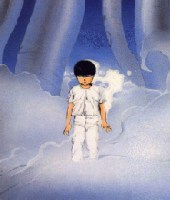![]()
![[ rated m ]](../common/rated_m.jpg) Akira
Akira
A Parent's Guide to Anime
Rated: M
Recommended for Mature Audiences
Reviewed by Don Kreipke:
Visually spectacular cyberpunk movie of near future Tokyo that brings together juvenile delinquents, the army, psionic children, terrorists, and corrupt politicians in a very complex plot. Moderate violence, scattered slightly vulgar language, and a fleeting sequence of chest-up nudity are present but completely overshadowed by the animation itself, which becomes extraordinarily intense at the climax. Akira is regarded by some fans as the best technically rendered art in all of animation.
Reviewed by Will Harrison:
Akira is a compressed, if slightly truncated, version of Katsushiro Otomo's epic sci-fi manga creation. It's set in the 21st century city of post-apocalyptic Tokyo, Japan and revolves loosely around a group of juvenile delinquents, the police/army, corrupt politicians, a small team of rebels, and, most central to the story, several psionic children.

The conflict derives primarily from the inabilty to control these dangerous children. The story uses an omniscient third-person style of telling which lends itself well to the atmospere of the world. Coupled with this and the fact that there is no introspection or internal character dialogue, it's almost like looking through a window into a real world ("real" if it weren't for these super-evolved children). This is common to most of Otomo's stories; he takes a world which is realistic to every seemingly insignificant detail and then throws in a spanner and lets the sparks fly.
As a parent, you will find objectionable content throughout the film -- mainly in the form of extreme and brutal violence. There is also one brief nude scene. Profanity-wise there is none that I can recall. This is unquestionably a mature-audiences-only film.
As far as a springboard to discussion, Akira is mostly unsuitable (unless, of course, you can find some kind of remote parallel between real life and grotesque super-human metamorphic transformation). There are, however, underlying messages and morals regarding things like the inherently corrupted nature of man and the abuse of weapons of mass destruction which one could extrapolate from the overall story, but none which could be better or equally expressed in other notable sci-fi.
Reviewed by Warren Daske:
Do you enjoy deep political dramas? Stay clear away. Do you like kiddie flicks similar to Barney's Great Adventure? Stop reading now. Do you like Pokemon? Skip this review and go straight onto the next one. However, if you enjoy action-packed, sci-fi, cyberpunk adventure, keep reading, you might learn something. Twelve years ago, an animated film unlike anything ever seen or done before was released. It came from the mind of former graphic novelist Katsushiro Otomo, the creator of the original Akira graphic novel, and it became a huge success. Twelve years later, it remains as one of the most mindboggling sci-fi's ever made.
The story revolves around young Tetsuo, a gang member in post-apocalyptic Tokyo, a.k.a. Neo-Tokyo. After a strange turn of events, Tetsuo becomes wound up in a government conspiracy aimed towards children with ESP. Unknown to Tetsuo, however, a strange psychic force, known only as AKIRA, has begun to manifest itself in Neo-Tokyo, and is using recurring dreams to contact Tetsuo. As Tetsuo slowly begins to lose his sanity, he is forced to risk everything to uncover the mystery of AKIRA. Meanwhile, Tetsuo's friends, led by Kaneda, in an attempt to rescue Tetsuo, become wound up with a resistance group led by Kay and Roy, whose sole purpose is to gather information about the test subjects being used in the experiments.
What follows is some of the most suspenseful action since The World Is Not Enough, featuring an underground escape with a high-tech security system, a psychic battle between Tetsuo and the other patients, and the final showdown between Tetsuo and Kaneda in an abandoned stadium. The animation is breathtaking, and has to be seen to be believed, and the music is absolutely spellbinding. However, Akira isn't a movie that would be recommended for the kids. It contains a substantial ammount of violence and gore, and a brief rape scene. Not enough to earn it a Canadian 18A rating, but enough that it would be considered 14A in todays theater. But if you're a teenager and are heavily into anime, Akira is the ultimate cyberpunk experience.
Parent's Guide Rating:
![]() red (recommended for mature audiences)
red (recommended for mature audiences)
Extreme violence throughout, one brief nude scene.
Akira may be a lot of things, but there isn't anything medium about it. I would call the level of violence in that movie Very High. There is also a attempted rape scene that involves some nudity. (DOC)
[ << prev ] [ top ] [ next >> ]
[ main ] [ rated g ] [ rated pg ] [ rated m ] [ rated x ] [ reviewers ] [ contribute ]
[ home ]
[ what's new ]
[ café contest ]
[ café reviews ]
[ parent's guide ]
[ encyclopædia ]
[ café trivia ]
[ café latté ]
[ café espresso ]
[ about the café ]
[ feedback ]
[ links ]
[ site map ]
© 1997-2001. All rights reserved. The Animé Café logo and the Crystal Kyoko award are original creations of the Animé Café. Please do not use any of the materials on this site without the expressed written permission of the Animé Café.
Page last modified 2001.04.21
